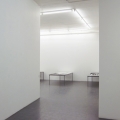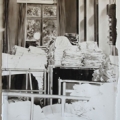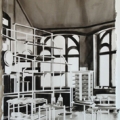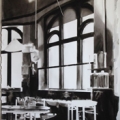Galleri Flach has the pleasure to present Amanda Kristina Pedersen’s Physiognomical Inquiries, the second solo show by Kristina Bength at the gallery. Amanda Kristina Pedersen’s Physiognomical Inquiries is also interpreted by the writer and essayist Vendela Fredricson in texts and a recorded reading.
Amanda Kristina Pedersen was a photographer and actress who in the early 1900s was convicted of fraud and forgery in Kristina Bength’s hometown of Falun. She went under numerous different names and identities, and portrayed herself alternately as a woman and as a man. On the release of Amanda Kristina Pedersen in 1904, the prison authorities enforced the taking of her portrait. In contrast to male inmates she isn’t dressed in prison robes for the occasion, but neatly dressed up as a bourgeois woman, perhaps in the hope of that she from now on will fit into this role.
The time when Amanda Kristina is convicted of her crimes and serves her sentence is a time when law enforcement agencies and medical institutions frantically photograph their inmates and patients, believing that the body carries the outer signs that reveal a person’s inner character. Beyond physiognomic classification, this practice was about tracing the individual’s qualities, personality and character, and thereby creating her life narrative and predicting her fate to come. But can a person be understood by her appearance?
For a time, Amanda Kristina Pedersen worked as a hospital photographer, and in the archives she got to see a large number of medical photographs; photographs in which individuals are to represent something other than themselves; photographs the gaze of which defines bodies in terms of what is normal and what is deviant; that conflate ugliness to sickness, and beauty to health.
In the physiognomical inquiries of Amanda Kristina Pedersen there are however no such images on display. Instead, twelve medical photographs have been replaced by as many watercolour paintings that derive their subject and composition from the photographs taken by Amanda Kristina Pedersen during her time as a hospital photographer. The gaze of the camera is turned away from the patients’ faces and bodies, and turned instead towards the hospital’s and clinic’s architecture and properties.
Hence, the paintings relate to the subjects and normativity of the clinical photographs by inverting the perspective: where the patient, loaded with symptoms, was scrutinized by the gaze of the doctor and the hospital photographer, the beholder now faces painted excerpts of the institutional rooms that contained this gaze.
The paintings are accompanied by as many medical records. If one regards how clinical photography and medical records worked in their context, it was about seeing, and defining, who the other is; a yearning for making visible and controlling that manifested itself in sorting, categorizing and distinguishing actions. Essentially every patient file up to the mid-1900s begins with a description of facial and corporeal characteristics as a part of the doctor’s narrative description of the illness.
Physiognomy appears as central a category as sex, class and age in capturing the character of an illness. In that case text and images support each other in accordance to the propensity of the gaze to see what it wants to see. Conversely, in Amanda Kristina Pedersen’s texts, through the relation to the images, such an identity is disarmed. At her hand, the medical records almost immediately abandon
the objective pretensions of the record and get subjectively coloured byher history and personal experience. She resumes physiognomy, wrests it out of the hands of science and scrutinizes her gaze on the grounds of the experience of both defining and being defined















